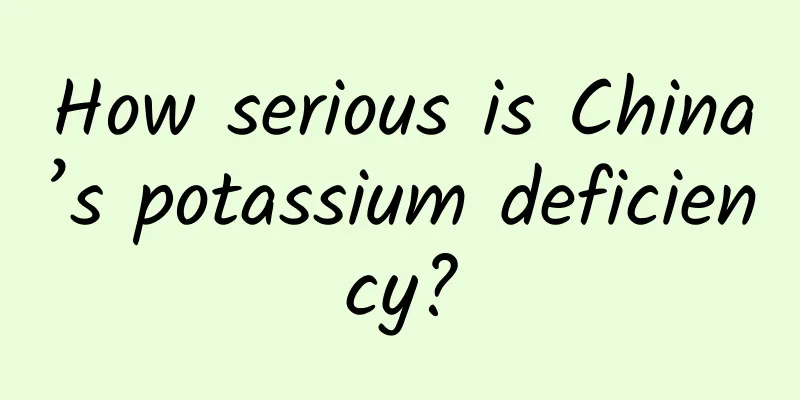How serious is China’s potassium deficiency?

|
We often hear that China feeds 20% of the world's population with 9% of the world's arable land, and consumes 33% of the fertilizers. The implication is that, with limited arable land, it is our fertilizer industry that supports agricultural self-sufficiency. The question is, can we be self-sufficient in fertilizers? Of the three major fertilizers, nitrogen, phosphorus and potassium, we have no shortage of the first two, but the third one is not enough, and the gap is huge. This is because China is now very short of "potash" , which is the main source of potassium. When many people hear the word "salt", they think that there is no shortage of salt. We have so much salt that we can't eat it all. The salt from Qaidam in the middle school textbooks is enough for the whole human race to eat for thousands of years. Copyright images in the gallery. Reprinting and using them may lead to copyright disputes. But what the textbook is actually talking about is table salt, which is sodium chloride. There are hundreds of types of salt in the chemical sense, and potassium salt is a strategic resource among them , which is directly related to the food problem of various countries . 5% Reserves Achieve 15% capacity increase 56% of China's arable land needs "potassium supplementation". Generally speaking, the situation becomes more serious as you go southeast. The soil potassium content in Fujian, Hunan, Hubei, Guangdong and Hainan is very scarce. The Jianghuai agricultural area further north is also very potassium-deficient, with the high-efficiency potassium content being only half or even a quarter of that in Xinjiang and Guanzhong agricultural areas. Potassium deficiency in the soil will seriously affect plant metabolism, increase the risk of pests and diseases and lodging, inhibit plant growth, and lead to yield reduction , especially for legumes and potato crops, which will seriously affect the yield . In 2017, farmers in Siziwang Banner, Inner Mongolia, used fake and inferior fertilizers, which led to a significant reduction in the yield of 20,000 mu of potatoes. The fake and inferior potassium sulfate fertilizers were tested to contain zero potassium. In 2023, China's potash gap will reach 68%, and it will have to import more than 10 million tons (11.57 million tons, US$463.61 billion), and our import options are very limited because potassium is highly monopolized on the global resource side. China's potash market is in short supply Importing potash costs a lot of money According to data from the United States Geological Survey, the world's recoverable potash reserves will be 3.6 billion tons (equivalent to K2O) in 2023, with Canada, Belarus, Russia and the United States accounting for 76%. China is second only to the United States, at 5% , which is even less than the proportion of our arable land. The world's recoverable potash reserves (converted to K2O) are greater than 3.6 billion tons, with Canada at 1.1 billion tons, Belarus at 750 million tons, Russia at 650 million tons, the United States at 220 million tons, and China at 180 million tons. This mere 5% is basically concentrated in three places: the Qaidam Basin in Qinghai, the Lop Nur Salt Lake in Xinjiang, and the Tibetan Plateau Salt Lake Area. Since the development of northern Tibet is too difficult, it currently relies mainly on Qaidam and Lop Nur . Based on these three places, Salt Lake Co., Ltd. (Qinghai), Zangge Holdings (Qinghai), and Guotou Luo Potassium (Xinjiang) account for 70% (72%) of the national production capacity. The most visible potash resources in Lop Nur, the "Ear of the Earth" In middle school textbooks, we often call the various basins and salt lakes in the west "treasure bowls", but this is not the case when it comes to potassium resources. The world's potassium salt resources are divided into two types: solid and liquid. Solid potassium salt is obviously superior to liquid in terms of grade, scale and development cost. Canada, Belarus and Russia all mainly produce solid potassium salts. For example, in the Nepa Basin in Russia, the Saskatchewan potash belt and the New Brunswick potash belt in Canada, the grade of solid potassium salt is as high as 25% to 30%. The Lanigan potash mine in Saskatchewan, Canada, has recoverable reserves of 550 million tons, three times the total amount in my country, and there are also potential total resources of 9.4 billion tons, which is truly endless. In contrast, in China, 98% of the salt is brine potassium. The brine grade of the Qarhan potassium salt base is 1.95%~1.50% potassium chloride, and the salt lake is also soaked with various elements such as magnesium, boron, lithium, rubidium, etc. (magnesium, boron, lithium, rock salt, Glauber's salt, rubidium, cesium, bromine), and potassium is just one of them. According to the survey report, the average grade of potassium chloride in Qaidam is only 0.46%, less than 1% (Figure: "One Hundred Achievements of China's Geological Survey") To put it in a more emotionally intelligent way, this type of mine needs comprehensive development and utilization . But everyone in this business knows that if you want to separate them one by one, the cost is very high, and it is far less simple and economical than the solid ore crushing, grinding, floating and filtering process. Of course, brine potassium salts can also be of very good quality. For example, the Dead Sea shared by Israel and Jordan is the world's largest liquid potassium salt mine. The bromine content of the Dead Sea is also very high. Israel and Jordan account for 70% (nearly 70%) of the world's bromine production. The salinity of the Dead Sea is about 34%, which is ten times the average salinity of the Earth's oceans. Unfortunately, China's development technology for salt lake associated resources (boron, lithium, magnesium, bromine) is not mature enough , and has long been high cost and low return. Despite all the natural disadvantages, China has mined potash beyond imagination. In 2023, the global potash production will be nearly 40 million tons (39.35 million tons), with China producing 6 million tons, second only to Canada and Russia, achieving 15% of production capacity with 5% of reserves. Potash prices hit historic highs It is this extraordinary performance that has maintained our 30% self-sufficiency rate, but the remaining 70% still has to be purchased from abroad. If you want to import, you can't avoid the following four potash fertilizer giants : These four giants account for 67% of global production and also monopolize the export of potash fertilizers in their respective countries. After all, almost all countries in the world need potash fertilizers, but there are only a few major producers. As a result, potassium salt stands out and becomes a rare "strategic resource" among salts. China is short of potassium, and several major agricultural countries such as Brazil, India and Indonesia are also in short supply. This problem is particularly evident in India, Southeast Asia, the Middle East and Africa, where the population is growing rapidly. Therefore, in the early stages of the Russia-Ukraine conflict, all countries were very concerned about two issues: one was whether food could be transported out, and the other was whether potash fertilizer could be transported out. The main production area of Russian potash fertilizer is the Perm Krai in the Ural region. To transport it to the Middle East, Africa or India, it must be shipped by sea, either via the Black Sea or the Baltic Sea. Schematic diagram of Russian potash fertilizer export routes It is about food, so only five months into the conflict, the Black Sea Grain Initiative was launched, and Russia also signed a memorandum of understanding with the United Nations on fertilizer exports. In short, you can fight as much as you want, but the export of food and potash fertilizers cannot be cut off. However, continuous supply does not mean no price increase. The potash fertilizer market in 2022 has left a deep impression on investors. The conflict between Russia and Ukraine continues, and Western countries have stepped up sanctions on Russia and Belarus, both of which are major potash fertilizer producers, with production capacity exports accounting for almost 40% of the world's total. More than half of my country's imported potash fertilizers also come from these two countries. Due to the mismatch between supply and demand, the price of potassium chloride has soared, reaching a historical high of 5,100 yuan per ton in mid-2022. “The bigger the storm, the more expensive the fish.” Obviously, the source of potash fertilizer is more scarce than oil and natural gas, and long-term dependence on a few countries will easily lead to being controlled by others. At present, according to China's recoverable potash reserves of 180 million tons and annual output of about 6 million tons, it is only enough for production for 20 to 30 years. After years of large-scale exploitation, the potash projects in Qaidam and Lop Nur have become increasingly depleted, and it is difficult to increase production capacity. Therefore, as early as 2016, potash was included in the "Strategic Mineral List" and is the focus of mineral exploration in my country. Many rounds of potash exploration in major basins in the west have been carried out, and breakthroughs have been made in Puguang in eastern Sichuan and Heibei Depression in Qaidam Basin. Heibei Depression is expected to become the third billion-ton potash resource base in China. The salt fields in Heibei Depression Modern China Inseparable from global resources But this amount of new reserves is still too small compared to our needs. Moreover, we cannot use up all the domestic reserves. The most direct way is to increase imports, expand sources and actively invest overseas . In China's current import mix, Russia, Belarus and Canada are in the first tier, while Israel and Jordan are in the second tier due to the Dead Sea. It is worth noting that potash from Laos has increased rapidly in recent years. Laotian potash is also very fragrant The potash mine in Khammouane Province, Laos is a world-class mine. China's Asia Potassium International and Laos Kaiyuan Mining have both invested here. This is the only overseas project in China's potash industry that has been put into production. By the end of 2022, the annual production capacity will be about 900,000 tons of potassium oxide. In addition, Yunnan Zhonglao Mining's 500,000-ton project under construction in Laos and Shandong Luyuan Group's potash project in Congo (Brazzaville) are both the second batch of major projects invested by Chinese companies overseas. Asia Potassium International expects to achieve an annual production capacity of 5 million tons in 2025, and Zangge Mining plans to reach an annual production capacity of 2 million tons of potassium chloride in 2026. Together with the projects of Oriental Tower and Yunnan Yuntianhua, by 2027, the total production capacity of these four companies in Laos will exceed 10 million tons, which can greatly alleviate China's import anxiety. One of the mines of Asia Potassium International in Khammouane Province, Laos We are really thankful to have a good relationship with Laos at our side at this time, but considering Laos’ share of global potassium reserves (2%), we obviously need more backup sources. China has been the world's largest consumer of potash for more than 20 years and will continue to be so for a long time. We cannot exhaust our limited domestic reserves and can only import a large proportion of them. This will inevitably test our ability to go overseas, go international, compete for pricing power, and engage in global governance. What's more, we need more than just potassium salt. Modern China cannot do without global resources. Are we ready for the soft and hard power and vision in all aspects that the future will require? References [1] A Potassium-Seeking Journey That Cannot Be Failed - The Paper [2] Mineral Commodity Summaries 2024 USGS [3] Zhang Yansong: Research on China’s Potash Resource Security Situation and Global Governance [4] Major Mines & Projects | Lanigan Mine (miningdataonline.com) [5] NATIONAL INSTRUMENT 43-101 TECHNICAL REPORT ON LANIGAN POTASH DEPOSIT [6] National Mineral Resources Planning (2016-2020) [7] China Geological Survey, “Global Mineral Resources Reserve Assessment Report 2023” [8] 2023-2029 China Potash Industry Development Status Analysis and Investment Strategy Research Report [9] Zhang Song Analysis of China's potash supply and demand situation Planning and production Source: Earth Knowledge Bureau (ID: diqiuzhishiju) Author: Boyue Editor: Yinuo Proofread by Xu Lai and Lin Lin The cover image and the images in this article are from the copyright library Reprinting may lead to copyright disputes |
<<: New scientific discovery! A guide to the parasites of the "poison king" of bat flies
Recommend
Is our universe a drop of water in the "cosmic ocean"? The "multiverse" makes science fiction shine into reality →
Author: Duan Yuechu and Huang Xianghong On August...
9 key points for a complete event planning program!
In marketing operations, marketing activities, as...
Can Lei Jun’s dream of creating a Chinese Sony come true?
What is Lei Jun's dream for Xiaomi? At Xiaomi...
What? Sea urchins have teeth? They chewed through more than 40 steel columns?
In 1953, an astonishing report appeared: in Calif...
TrendForce: Global Power Battery Recycling Market to Exceed 1 Trillion Watt-hours in 2030
TrendForce predicts that the rapid growth of glob...
Why is it that the taste of beautiful cherry blossom-flavored food is always hard to describe?
With the coming of spring, many businesses are ru...
We are all pursuing high emotional intelligence, so why do we insist on low entropy in life?
The famous physicist Schrödinger once said in his...
Starting from Dash iOS open source, don’t pursue perfect code too much
(Screenshot of Dash iOS source code) Some time ag...
Integrated Marketing Lights up Baidu World Baidu LBS Leverages the Trillion-dollar Life Service Market
O2O is a big market, including hotels, shops, res...
Internet opium: fake orders
[[134460]] Recently, a piece of news about Uber f...
Don't step on the white block game source code
Source code introduction This project is a game s...
Electronic power steering may suddenly fail. Geely will recall 40,000 Borui vehicles
Recently, Zhejiang Geely Automobile Co., Ltd. fil...
Is the protagonist of the Year of the Rabbit the same rabbit as Spicy Rabbit Head?
The Year of the Rabbit is approaching, and rabbit...
Hidden in the dusty archives, the scientist who invented the best-selling breast cancer drug
In the process of scientific development, the con...
A new cold front arrives tonight! Where will there be a blizzard? | Expert interpretation
The Central Meteorological Observatory predicts N...









